 |
 |
 |
 |
 |
 |
| |
 |
|
 |
 |
 |
  |
  |
 |
 |
 |
 |
|
|
 |
|
 |
 |
 |
OPERA |
 |
|
 |
|
 |
 |
 |
| |
 |
| 
 |
Markthal
Mercati generali |
|
 |
 |
 |
 |
PROGETTISTA |
 |
|
|
 |
|
 |
 |
 |
| |
 |
|
 |
 |
 |
 |
CONTESTO |
 |
|
|
 |
|
 |
 |
 |
| Localizzazione |
 |
|
 |
|
 |
 |
 |
|
 |
|
| Rapporto con il luogo |
 |
|
 |
|
 |
 |
 |
|
 |
|
| Valenza dell'edificio nel territorio e nella città |
 |
|
 |
|
 |
 |
 |
 |
 |
 |
 |
DESCRIZIONE |
 |
|
|
 |
|
 |
 |
 |
| . |
 |
|
 |
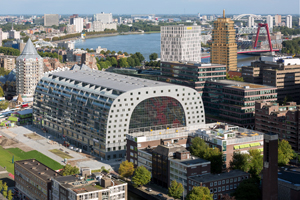 Rotterdam has a new icon: Markthal Rotterdam. At a historical location at the Binnenrotte, next to Blaak Station and the largest weekly open air fresh food and hardware market in Rotterdam, the first covered market of the Netherlands was realised. Markthal includes a huge market floor on the ground floor under an arch of apartments. Its shape, its colourful interior and the height turns Markthal into an unique spectacle. Unique is not only its shape and size, but especially the way the different functions are combined. The combination of an apartment building covering a fresh food market with food shops, restaurants, a supermarket and an underground parking is found nowhere else in the world. Rotterdam has a new icon: Markthal Rotterdam. At a historical location at the Binnenrotte, next to Blaak Station and the largest weekly open air fresh food and hardware market in Rotterdam, the first covered market of the Netherlands was realised. Markthal includes a huge market floor on the ground floor under an arch of apartments. Its shape, its colourful interior and the height turns Markthal into an unique spectacle. Unique is not only its shape and size, but especially the way the different functions are combined. The combination of an apartment building covering a fresh food market with food shops, restaurants, a supermarket and an underground parking is found nowhere else in the world. |
|
 |
 |
 |
|
 |
|
| Location |
 |
|
 |
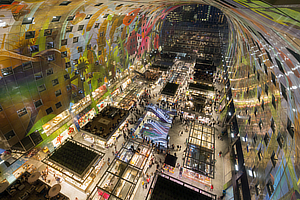 Urban transformation Urban transformation
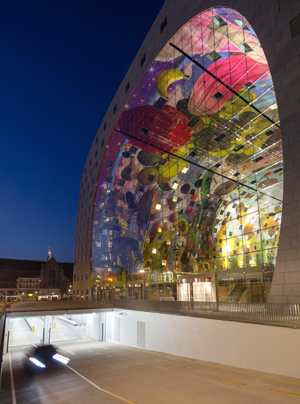 Markthal was a success already before being realised: it is a new and fresh icon which already has attracted large quantities of international press and visitors. The centrally located building is rooted in the city’s history, located parallel to the late medieval ‘Laurenskerk’ (Laurens church) and at the location of the former dike along the river Rotte. This river was diverted at the end of the 19th century in favour of a train line viaduct leading to the south bank of the river Maas. In the 1990’s this trajectory was rebuilt as an underground tunnel and the current oblong square emerged which offers room for the open air fresh food market twice a week. The 1950’s buildings on either side of the old highline suddenly faced the new square with their backsides and have been replaced ever since. Markthal was a success already before being realised: it is a new and fresh icon which already has attracted large quantities of international press and visitors. The centrally located building is rooted in the city’s history, located parallel to the late medieval ‘Laurenskerk’ (Laurens church) and at the location of the former dike along the river Rotte. This river was diverted at the end of the 19th century in favour of a train line viaduct leading to the south bank of the river Maas. In the 1990’s this trajectory was rebuilt as an underground tunnel and the current oblong square emerged which offers room for the open air fresh food market twice a week. The 1950’s buildings on either side of the old highline suddenly faced the new square with their backsides and have been replaced ever since.
Markthal means an important impulse to its surrounding area which is a strong contribution to the urban economy. Markthal with its daily fresh food market, shops and apartments, creates coherence and connections in the neighbourhood which will reach a new centrality. After completion of Markthal, the city of Rotterdam will start to refurbish Binnenrotte Square to make it more attractive also on days that there is no outdoor market. After the refurbishment the outdoor market will be reconfigured, the market lanes will connect seamlessly to the entrances of Markthal, to allow the public to easily enter and exit the building and to create incentives between the two markets, indoor and outdoor.
The building is a new statement in the urban structure of Rotterdam with its high diversity of icons from the days of reconstruction and urban renewal, but also some new buildings that have been realised over the last years. It is in line with the city’s ambition to house more people in the centre and to raise the life quality in post-industrial Rotterdam through a series of large scale projects and countless bottom-up projects. The combination of styles of architecture forms an excellent environment for the spectacular design of Markthal.
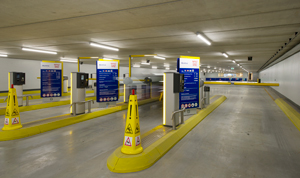 Accessibility Accessibility
Markthal is accessible by all means of transport. Blaak train station is right in front of the building and serves also as metro, bus and tram hub. In 2015 the city of Rotterdam will construct a recessed bicycle parking right next to Markthal with space for 800 bikes. Next to this excellent accessibility by public transport Markthal is also easy accessible by car. The four underground parking levels offer 1.200 parking places. As part of the general transformation of the ‘Laurenskwartier’ (Laurens quarter) neighbourhood these parking places are not only available to inhabitants but also open to visitors of Markthal, the library, the outside market and tourist attractions in the area. A new traffic plan in the vicinity of the car park entrance will avoid queues, Markthal parking will be open 24/7.
Parking Markthal
The 1.200 parking places are an important addition to the capacity of ‘Laurenskwartier’ (Laurens quarter) neighbourhood and part of the urban transformation. The underground car park is open 24/7 and equipped with latest technology such as a parking guidance system, licence plate recognition, online reservation system and charging points for electric vehicles. Visitors of Markthal, the library, the outdoor market or the city of Rotterdam can park here - as well as the inhabitants of Markthal.
These innovative technologies are geared towards a more sustainable parking: the sophisticated parking guidance system and the license plate recognition help avoid unnecessary driving inside the garage whilst the online booking system is a customer service intervention avoiding traffic in the neighbourhood. |
|
 |
 |
 |
|
 |
|
| Architecture |
 |
|
 |
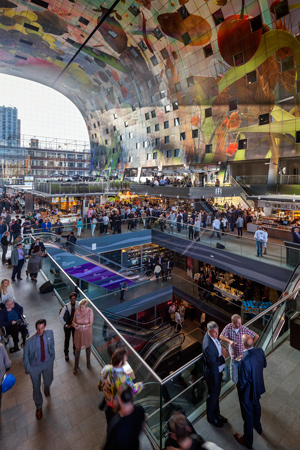 In October 2004 the team of Provast developers and architecture studio MVRDV won a competition organised by the city of Rotterdam for the design and construction of a market hall at Binnenrotte. The municipality wanted to extend the existing open air market with a covered addition. In October 2004 the team of Provast developers and architecture studio MVRDV won a competition organised by the city of Rotterdam for the design and construction of a market hall at Binnenrotte. The municipality wanted to extend the existing open air market with a covered addition.
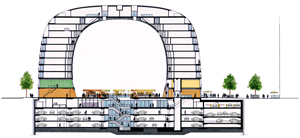 According to stricter European rules in the future the open air sale of fresh and chilled food would not be permitted anymore. Next to this the municipality wanted to augment the amount of inhabitants in the city centre in order to create more capacity for the services in the area. The demanded programme – housing, parking and a market hall – asked for an obvious solution: two residential slabs with an economically constructible market hall in between. Provast and MVRDV had seen in the South of Europe that these kind of market halls are often dark, introverted buildings with little connection to the surrounding urban area. The Markthal in Rotterdam however was to be an important impulse in the development of the ‘Laurenskwartier’ (Laurens quarter) neighbourhood and had to strengthen the Eastern side of the city centre. A highly public, open building with good accessibility was needed. The team decided to just flip the two slabs and market which led to a larger hall with two wide openings towards the city. In order to make the construction more efficient a curve was chosen that fitted a traditional elevator core. By adding some space to the lower floors for extra retail space the current volume of the arch emerged 120 meters long, 70 meters wide and 40 meters tall. According to stricter European rules in the future the open air sale of fresh and chilled food would not be permitted anymore. Next to this the municipality wanted to augment the amount of inhabitants in the city centre in order to create more capacity for the services in the area. The demanded programme – housing, parking and a market hall – asked for an obvious solution: two residential slabs with an economically constructible market hall in between. Provast and MVRDV had seen in the South of Europe that these kind of market halls are often dark, introverted buildings with little connection to the surrounding urban area. The Markthal in Rotterdam however was to be an important impulse in the development of the ‘Laurenskwartier’ (Laurens quarter) neighbourhood and had to strengthen the Eastern side of the city centre. A highly public, open building with good accessibility was needed. The team decided to just flip the two slabs and market which led to a larger hall with two wide openings towards the city. In order to make the construction more efficient a curve was chosen that fitted a traditional elevator core. By adding some space to the lower floors for extra retail space the current volume of the arch emerged 120 meters long, 70 meters wide and 40 meters tall.
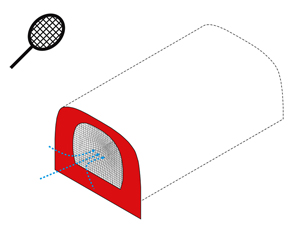 The building needed to be as open as possible to attract the public and at the same time it had to be closed off due to weather conditions. Keeping the closure as transparent as possible a cable net façade was chosen which needs very few constructive elements. Its principle is comparable to a tennis racket in which the steel cable are used as strings in between which the glass is mounted. This cable net façade is the largest of its kind in Europe. Because of this miracle of engineering the art piece inside is visible from the outside, its lush shapes and colours invite the public to enter the building. The exterior of the Markthal is executed in grey natural stone, the same as on the pavements, to put the emphasis onto the interior. The building needed to be as open as possible to attract the public and at the same time it had to be closed off due to weather conditions. Keeping the closure as transparent as possible a cable net façade was chosen which needs very few constructive elements. Its principle is comparable to a tennis racket in which the steel cable are used as strings in between which the glass is mounted. This cable net façade is the largest of its kind in Europe. Because of this miracle of engineering the art piece inside is visible from the outside, its lush shapes and colours invite the public to enter the building. The exterior of the Markthal is executed in grey natural stone, the same as on the pavements, to put the emphasis onto the interior.
Markthal is a building without a backside. All sides of the building are accessible or shop windows. The entire supply for the hall, the shops and restaurants is therefore located underground. The first basement floor features an expedition court to which the delivery can happen with vans, from this exhibition court freight elevators reach the market hall. In this way inhabitants are not hindered by distribution activities that often occur in the early hours of the morning. Also in the basement is an Albert Heijn supermarket, Etos and Gall & Gall. The delivery for these stores is organised through an underground tunnel leading to hidden elevators at Binnenrotte square, in this way larger lorries can operate in distance to the hall. Inhabitants have storage rooms and shared bicycle rooms in the basement.
Inhabitants can reach their apartments through six separate entrances leading to elevators and double helix flight stairs. Due to the curve of the structure the elevator hall is gradually - floor by floor – changing in size and location. At the ground floor the elevator is located at the inner façade, at the top floor towards the outer façade. Each elevator hall services a maximum of four apartments, two of which have windows to the market and all have large glass fronts towards the outside. |
|
 |
 |
 |
|
 |
|
| . |
 |
|
 |
|
 |
 |
 |
|
 |
|
| Horn of Plenty |
 |
|
 |
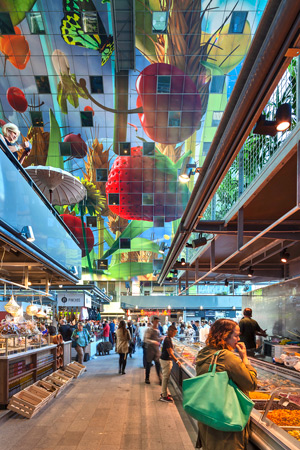 The interior of the arch is covered by the gigantic art piece Horn of Plenty, a multi-coloured creation by Rotterdam artists Arno Coenen and Iris Roskam. The art piece is made with Pixar Animation software depicting a photographic 3D illusion of fresh products such as fruit, fish, bread, flowers and also the tower of adjacent ‘Laurenskerk’ (Laurens church). Horn of Plenty refers to the great still-lives of the Dutch golden century, to the Greek mythology in which Cornucopia is a legendary object and to the tradition of artistic arch decoration known from places such as the Sistine Chapel. The artwork evokes the illusion of laying on your back in a meadow, looking up, right through Markthal towards the sky. The sun in the centre figures as Horn of Plenty from which the fresh produce falls down to earth. The interior of the arch is covered by the gigantic art piece Horn of Plenty, a multi-coloured creation by Rotterdam artists Arno Coenen and Iris Roskam. The art piece is made with Pixar Animation software depicting a photographic 3D illusion of fresh products such as fruit, fish, bread, flowers and also the tower of adjacent ‘Laurenskerk’ (Laurens church). Horn of Plenty refers to the great still-lives of the Dutch golden century, to the Greek mythology in which Cornucopia is a legendary object and to the tradition of artistic arch decoration known from places such as the Sistine Chapel. The artwork evokes the illusion of laying on your back in a meadow, looking up, right through Markthal towards the sky. The sun in the centre figures as Horn of Plenty from which the fresh produce falls down to earth.
H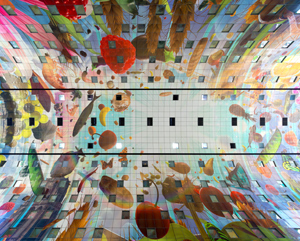 orn of Plenty is one of the largest art pieces of the Netherlands. Its technology is unique, the fresh produce seems photographed but is built in the computer, piece by piece. The 3D impression is detailed in the same resolution suitable for a glossy magazine. In total the image consist of 400.000 megapixels. 1.470 gigabyte have been sent to the printer, in parts, as one computer could never open such a large file. orn of Plenty is one of the largest art pieces of the Netherlands. Its technology is unique, the fresh produce seems photographed but is built in the computer, piece by piece. The 3D impression is detailed in the same resolution suitable for a glossy magazine. In total the image consist of 400.000 megapixels. 1.470 gigabyte have been sent to the printer, in parts, as one computer could never open such a large file.
The 11.000 m² art work have been screwed against the wooden interior facade of the hall in which must have been the largest puzzle of Europe. Each of the 4.500 aluminium panels sized 1,52 cm by 1,52 cm needed to be mounted in the right way at the right spot. The 2 mm thick panels are perforated in order to absorb noise from the hall, this helps to create the excellent acoustic profile of the halls interior.
One piece in the centre of the art work is left white; here throughout the entire year an animation will be projected in the evening, this ‘video-mapping’ will change and respond to themes such as season and food. |
|
 |
 |
 |
|
 |
|
| . |
 |
|
 |
|
 |
 |
 |
|
 |
|
| Living |
 |
|
 |
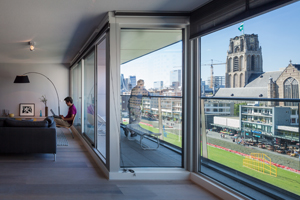 Markthal Rotterdam is a completely new concept, the first building of its kind, a hybrid between market hall and housing. Rotterdam experiences a world-wide scoop with this new urban typology. By using the apartments to create an arch that covers the market a new public building emerges, which could not have been this grand without the housing. Markthal Rotterdam is a completely new concept, the first building of its kind, a hybrid between market hall and housing. Rotterdam experiences a world-wide scoop with this new urban typology. By using the apartments to create an arch that covers the market a new public building emerges, which could not have been this grand without the housing.
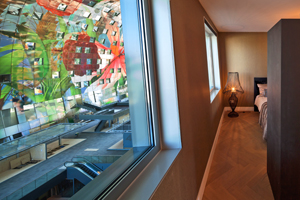 The horse shoe shaped arch of Markthal consists of housing from the third to the eleventh floor, in total 102 rental apartments and 126 apartments for sale. Each apartment has an outside terrace over the full width of the unit and the 24 penthouses on the top floor have – thanks to the arch shape – a very wide roof terrace. The apartments can be accessed via 6 entrances at street level. The horse shoe shaped arch of Markthal consists of housing from the third to the eleventh floor, in total 102 rental apartments and 126 apartments for sale. Each apartment has an outside terrace over the full width of the unit and the 24 penthouses on the top floor have – thanks to the arch shape – a very wide roof terrace. The apartments can be accessed via 6 entrances at street level.
Half the apartments has windows to the market, these windows are triple glazed to avoid sound or smell nuisance. There is a broad choice of apartment types, from free layout loft apartments to duplex with multiple bedrooms. The properties vary from 80 to 300 m². The penthouses have their entrances on the tenth floor and inside stairs and room for an elevator to the eleventh floor, in this way the arch of Markthal could be realised without any elevator boxes on the roof. |
|
 |
 |
 |
|
 |
|
| . |
 |
|
 |
|
 |
 |
 |
|
 |
|
| Archaeology |
 |
|
 |
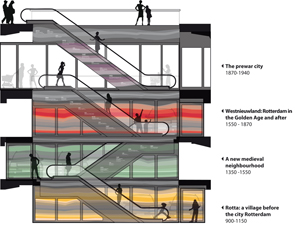 In 2009 and 2010 the Archaeology Department of the city of Rotterdam (BOOR) has conducted a large excavation in the construction site of Markthal. Typical eccentricity in Holland: the archaeological research started at a depth of 3 meters underneath sea level. The Markthal site was extremely interesting for archaeologists as it is the very place where Rotterdam was founded in 1270 by construction of a dike in the river Rotte. In 1340 Rotterdam received the status of a city and was expanded towards the current Blaak station. In 2009 and 2010 the Archaeology Department of the city of Rotterdam (BOOR) has conducted a large excavation in the construction site of Markthal. Typical eccentricity in Holland: the archaeological research started at a depth of 3 meters underneath sea level. The Markthal site was extremely interesting for archaeologists as it is the very place where Rotterdam was founded in 1270 by construction of a dike in the river Rotte. In 1340 Rotterdam received the status of a city and was expanded towards the current Blaak station.
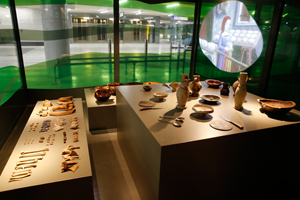 In the 16th century the population of Rotterdam grew rapidly. On the site of Markthal was a densely populated neighbourhood with residential buildings and herring fishing companies which were since the 17th century gradually replaced by inn’s, shops and office buildings. During the bombardment in May 1940 all historic urban fabric was destroyed. After the war a school was built on the site which was demolished for the construction of Markthal. The school moved into an empty office building at the western façade of Markthal, from their class rooms and the roof top playground the pupils have great vistas through the entire length of Markthal. The research by BOOR was executed under great public interest and shows in great detail how a thousand years ago, at the site of Markthal, pioneers started to cultivate the land and made a living. In the 16th century the population of Rotterdam grew rapidly. On the site of Markthal was a densely populated neighbourhood with residential buildings and herring fishing companies which were since the 17th century gradually replaced by inn’s, shops and office buildings. During the bombardment in May 1940 all historic urban fabric was destroyed. After the war a school was built on the site which was demolished for the construction of Markthal. The school moved into an empty office building at the western façade of Markthal, from their class rooms and the roof top playground the pupils have great vistas through the entire length of Markthal. The research by BOOR was executed under great public interest and shows in great detail how a thousand years ago, at the site of Markthal, pioneers started to cultivate the land and made a living.
‘De Tijdtrap’ (The Time Stair): Middle Ages underneath the Markthal
‘De Tijdtrap’ is a lasting memoir of the archaeological research conducted at the Markthal site. It presents the history of Rotterdam in a vertical exhibition alongside the escalator in the centre of Markthal which connects the hall to the four underground levels. The deeper the escalator goes, the more in depth the history of Rotterdam is presented in a number of displays with findings and models, accompanied by sound and images. Together they tell the story of the beginning of Rotterdam and its history of food. |
|
 |
 |
 |
|
 |
|
| Construction |
 |
|
 |
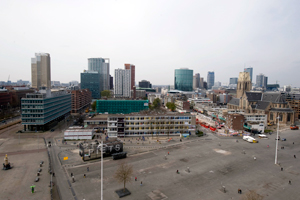 Construction was started October 1st 2009 by contractor combination Mobilis and Martens en Van Oord. Before this the school and parking garage which occupied the site before had been demolished. The school was relocated by Provast into a 1960’s office building right next to Markthal. On its roof is the school playground, kids have fantastic views into the length of Markthal. Construction was started October 1st 2009 by contractor combination Mobilis and Martens en Van Oord. Before this the school and parking garage which occupied the site before had been demolished. The school was relocated by Provast into a 1960’s office building right next to Markthal. On its roof is the school playground, kids have fantastic views into the length of Markthal.
Markthal is located at a historical location: the old dike along the river Rotte which was diverted at the end of the 19th century. The soil however is still extremely unstable and wet. To prevent a collapse of the construction site during excavation sheet piles were placed around the entire perimeter of the site. To provide a solid basis for laying the foundations 2500 heavy concrete piles were hammered into the wet soil. Containers were placed along the site as sound barrier.
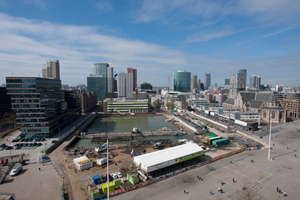 One of the many specialties during Markthal’s construction was the great depth of the construction site, 15 meters. Groundwater ran already at a depth of 3 meters below street level. As the cofferdam was not supposed to float up during construction the concrete piles were used in this phase as tension piles to keep the site stable. On July, 1 2010 the pile works were completed and a concrete grid was constructed: this was at the same time the future floor structure of the first basement and a protection for the construction site, a smart combination. One of the many specialties during Markthal’s construction was the great depth of the construction site, 15 meters. Groundwater ran already at a depth of 3 meters below street level. As the cofferdam was not supposed to float up during construction the concrete piles were used in this phase as tension piles to keep the site stable. On July, 1 2010 the pile works were completed and a concrete grid was constructed: this was at the same time the future floor structure of the first basement and a protection for the construction site, a smart combination.
Now that the walls were secured, pumps were brought in and made it possible to excavate the site until a depth of 8 meters. This gave the archaeologists space to research the remains of the first settlement of Rotterdam dated 1270. In order to be able to execute the works until the depth of 15 meters below the pavement and to not pressure the walls and floors the site was then filled with water. One can compare this to a bucket which is lowered down into water, this is difficult if the bucket is empty and easy if the bucket is filled with water. Cranes on floating platforms dug the site up assisted by GPS technology to avoid the concrete construction to be damaged. The last meters were dug out with a sludge piston which was designed especially for Markthal in a way to avoid touching the piles.
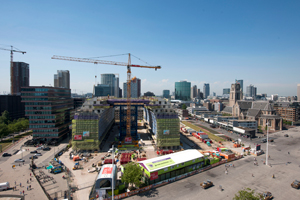 In summer 2011 the divers started to lay the reinforcements for the concrete floor 15 meters under water, this was done in heavy duty diving suits, on touch, without any view in the murky water. The concreting took 72 hours. Day and night a 1,5 meter thick layer of underwater concrete was laid, 1500 lorry loads. December 2011 the site was slowly pumped dry, the floor which had to carry a weight of 12.000 kilo per m² appeared watertight. From this moment on, the site was dry and it took another year to complete the underground car park. Then the specialist work was done and contractors changed. In summer 2011 the divers started to lay the reinforcements for the concrete floor 15 meters under water, this was done in heavy duty diving suits, on touch, without any view in the murky water. The concreting took 72 hours. Day and night a 1,5 meter thick layer of underwater concrete was laid, 1500 lorry loads. December 2011 the site was slowly pumped dry, the floor which had to carry a weight of 12.000 kilo per m² appeared watertight. From this moment on, the site was dry and it took another year to complete the underground car park. Then the specialist work was done and contractors changed.
Construction company J.P. van Eesteren started on 1st of October 2012 with the construction of the arch. The construction of the two sides was done fast and economical by means of tunnel shuttering, which worked from the second to the tenth floor. The roof of the arch was realised in four parts supported by a temporary driving construction underneath, a so called Super Support Construction (in Dutch SOC). Inside the concrete, small Wi-Fi-devices indicated whether the concrete was hardening according to plan.
The steel cables of the cable net façade bear a tension of 25.000 to 30.000 kilo, the equivalent of 27 VW Golf cars. Because of this high tension, the cables have grown 9 to 15 cm. The façade is flexible and during heavy storms the wind can push the centre of the façade 70cm inwards, which will make the cables another 4cm longer. In summer 2014 Markthal was closed off by the façade and the construction of the fresh units and stores inside the hall started. For the construction of the market stalls 3 tons of steel was used. At the end of construction but well before the completion date, the Markthal construction site had already attracted 12.000 visitors. |
|
 |
 |
 |
|
 |
|
| . |
 |
|
 |
|
 |
 |
 |
 |
 |
 |
 |
VIDEO |
 |
|
|
 |
|
 |
 |
 |
| |
 |
|
 |
 |
 |
 |
ECOSOSTENIBILITA' |
 |
|
|
 |
|
 |
 |
 |
|
|
 |
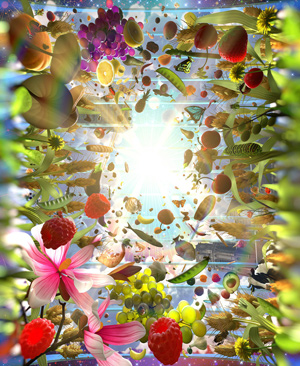 Markthal received a BREEAM Very Good certificate. The building is connected to city heating and a thermal storage system underneath the building which will also heat and cool a number of adjacent buildings in the surrounding area. Markthal received a BREEAM Very Good certificate. The building is connected to city heating and a thermal storage system underneath the building which will also heat and cool a number of adjacent buildings in the surrounding area.
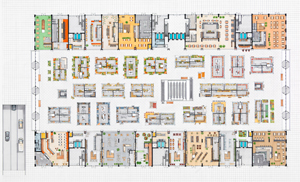 The various functions in the building can exchange heat and cold. For the hall itself extensive research was conducted to create a comfortable interior climate with an extremely low energy use. The hall is naturally ventilated, underneath the glass façade fresh air flows in, it rises towards the roof and leaves the hall through ventilation shafts in the roof. This is a thermic system which can function without any installations. A central monitoring system is used to exchange heat and cool between the different programmes, in this way less installations could be used than normal for these programmes. The combination of housing, shopping centre, parking and market hall makes the installation technology more efficient. Inside the market, an information panel illustrates the energy use and CO2 savings of the building. A smart sanitation system is designed to save water. The various functions in the building can exchange heat and cold. For the hall itself extensive research was conducted to create a comfortable interior climate with an extremely low energy use. The hall is naturally ventilated, underneath the glass façade fresh air flows in, it rises towards the roof and leaves the hall through ventilation shafts in the roof. This is a thermic system which can function without any installations. A central monitoring system is used to exchange heat and cool between the different programmes, in this way less installations could be used than normal for these programmes. The combination of housing, shopping centre, parking and market hall makes the installation technology more efficient. Inside the market, an information panel illustrates the energy use and CO2 savings of the building. A smart sanitation system is designed to save water.
The design vision of MVRDV describes Markthal as urbanism, the function mix is an integrated design, a 24 hour building which is a public and lasting addition to the city of Rotterdam.
The tenants of Markthal have signed a so called Green Lease Agreement regarding sustainable performance requirements. This covers the use of water, energy, waste and the use of healthy construction material. In this way the sustainable ambition reaches further than just the cask of the building.
An ecologist was invited to improve the ecological value of the inner city location and advised to create space for bats and swifts. On the western façade of the 11th floor are four large bat stays integrated into the façade, on the northern side of the first floor are ten nests for swifts mounted to the wall. |
|
 |
 |
 |
 |
 |
 |
 |
LOCALIZZAZIONE |
 |
|
|
 |
|
 |
 |
 |

|
 |

|
Continente |
|
 |
|
Nazione |
|
 |
|
Regione |
|
 |
|
Regione |
|
 |
|
Città |
|
 |
|
Indirizzo |
|
 |
|
|
|
 |
|
Sito web |
|
 |
|
 |
 |
 |
 |
MAPPA |
 |
|
|
 |
|
 |
 |
 |
| |
 |
|
 |
 |
 |
 |
|
TIPOLOGIA |
 |
|
|
 |
|
 |
 |
 |
Principale |
 |
|
 |
ARCHITETTURA | Edifici residenziali
Abitazioni plurifamiliari
Edifici commerciali
Mercati
| |
|
|
 |
|
Accessoria |
 |
|
 |
ARCHITETTURA | Edifici commerciali
Grandi magazzini, supermercati, centri commerciali, ecc.
Negozi
Edifici e strutture per i trasporti
Autorimesse, parcheggi, ecc.
| |
 |
 |
 |
 |
CRONOLOGIA |
 |
|
|
 |
|
 |
 |
 |
Progetto |
 |
|
 |
| 
 |
2009
progetto vincitore di concorso
|
|
Realizzazione |
 |
|
 |
| 
 |
2009 - 2014 |
|
 |
 |
 |
 |
PREMI |
 |
|
|
 |
|
 |
 |
 |
| 2016 |
 |
|
 |
European Innovation Award
German Council of Shopping Centres (GCSC) |
|
 |
 |
 |
|
 |
|
| 2016 |
 |
|
 |
| FGH Vastgoedprijs / FGH Real Estate Award |
|
 |
 |
 |
|
 |
|
| 2015 |
 |
|
 |
MIPIM Award
Best Shopping Centre |
|
 |
 |
 |
|
 |
|
| 2015 |
 |
|
 |
| NEPROM Prize for Urban Development |
|
 |
 |
 |
|
 |
|
| 2015 |
 |
|
 |
|
 |
 |
 |
|
 |
|
| 2015 |
 |
|
 |
|
 |
 |
 |
|
 |
|
| 2015 |
 |
|
 |
Gold Award
European Standard Parking Award (ESPA) |
|
 |
 |
 |
|
 |
|
| 2015 |
 |
|
 |
Rotterdam Architecture Award
AIR, Rotterdam architecture centre
"An unprecedented project that allows a completely new typology was invented."
"The Markthal contributes great value to the housing supply from Rotterdam. Come to live with market functions, shops and restaurants in a festive buildings with undisputed iconic value. It is an asset for the city." |
|
 |
 |
 |
|
 |
|
| 2014 |
 |
|
 |
Rotterdam’s Marketing Award
The jury report mentions that “with the realisation of Markthal Rotterdam in the city centre something unique was created. In a short period this building has become an absolute must-see. Markthal received in the first weeks already one million visitors. Hundreds of positive publications about Markthal have been published in the national and international press. The project of which the two winners are figurehead has played an essential role in strengthening the reputation of the city and the brand of Rotterdam.” |
|
 |
 |
 |
 |
 |
 |
 |
RIFERIMENTI BIBLIOGRAFICI |
 |
|
|
 |
|
 |
 |
 |
|
 |
| Harm Tilman, "Markthalle in Rotterdam / Market hall in Rotterdam", Architektur Aktuell 420, marsch/march 2015 [Splendid Isolation #9], pp. 4-5 |
|
|
| Rob Bevan, "Vegetal vault", Architectural Review 1415, january 2015, pp. 56-67 |
|
|
| Peter Smisek, "MVRDV's Markthal", Icon 138, december 2014, pp. 24-25 |
|
|
| Beth Broome, "Markthal, Rotterdam. MVRDV", Architectural Record 12/2014, december 2014, p. 180 |
|
|
| Clare Dowdy, "Market forces. MVRDV", Blueprint 337, november-december 2014, pp. 56-72 |
|
|
| "Market Hall, Rotterdam, Netherlands, 2014. MVRDV", A+U. Architecture and Urbanisme 529, october 2014 [Recent projects], pp. 74-81 |
|
|
| Emiel Lamers, "Mega market hall. MVRDV", A10 new European architecture 54, november /december 2013, pp. 4-6 |
|
 |
 |
 |
 |
 |
 |
 |
AGGIUNTE E DIGRESSIONI |
 |
|
|
 |
|
 |
 |
 |
| |
 |
|
#DGEVOLUTION, Milano, Palazzo Labus, 4 / 9 April 2017
MVRDV takes part in the exhibition to launch #DGEVOLUTION featuring six international architecture firms chosen to create a new conceptual vision for future Dolce&Gabbana boutiques.
Dolce&Gabbana ushers in a new era for its luxury retail boutiques by handing over creative freedom to six international architecture firms, who will transform individual stores in Milan, Porto Cervo, Capri, Tokyo, St. Barth, London, Brussels, Monte Carlo, Venice, Beijing, Los Angeles and Dubai, whilst responding to both context and the brand's history.
MVRDV is set to design a new flagship location in line with this new approach. A one of a kind, location specific design in collaboration with the brand to bring a unique interpretation of the Dolce & Gabbana story for contemporary buyers. This heralds a more emotive, diverse and cultural influence on their boutiques making them experiential, and a move away from the now dated concept store model. The designers of the fashion house have initiated a dialogue with the chosen architects to create radical and unusual perspectives for the brand and their locations, making them one-of-a-kind
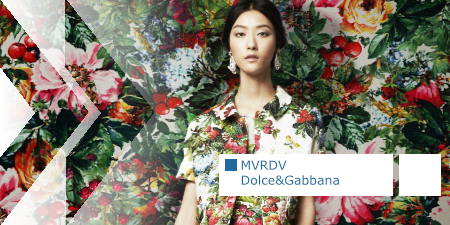 |
|
 |
 |
 |
 |
 |
 |
 |
COMMITTENTE |
 |
|
|
 |
|
 |
 |
 |
| |
 |
Markthal Rotterdam B.V.
Provast, Den Haag |
|
 |
 |
 |
 |
IMPORTO |
 |
|
|
 |
|
 |
 |
 |
| |
 |
|
 |
 |
 |
 |
DATI
DIMENSIONALI |
 |
|
|
 |
|
 |
 |
 |
| Larghezza |
 |
|
 |
|
| Lunghezza |
 |
|
 |
|
| Altezza |
 |
|
 |
|
| Consistenza |
 |
|
 |
228 appartamenti
100 banchi
26 negozi
2 supermercati |
|
| Superficie |
 |
|
 |
Horn of Plenty mq. 11.000
lotto mq. 20.600
facciate in vetro mq. 1.258 |
|
| Numero |
 |
|
 |
impianti di risalita:
17 ascensori
10 scale mobili
8 montacarichi
porte. ca. 2.500
228 terrazzi
24 verande
Horn of Plenty: 4.500 pannelli di alluminio |
|
| Quantità |
 |
|
 |
Impianti.
tubazioni km. 110
cavi elettrici km. 360
fognature km. 12,5
condotte acqua km. 20
calcestruzzo M3:
sottostruttura mc. 45.000
sovrastruttura mc. 21.000
2.500 pali |
|
| Peso |
 |
|
 |
t. 117.112
acciaio per cemento armato:
sottostruttura kg. 6.000.000
sovrastruttura kg. 2.000.000 |
|
| Capienza |
 |
|
 |
| parcheggio 1.200 posti auto |
|
 |
 |
 |
 |
STRUTTURISTA |
 |
|
|
 |
|
 |
 |
 |
| |
 |
D3BN/ DHV (The Hague, Netherlands)
Maurice Hermens |
|
 |
 |
 |
 |
STAFF |
 |
|
|
 |
|
 |
 |
 |
Progetto  |
 |
|
|
 |
|
Coprogettisti  |
 |
|
|
 |
|
Interventi artistici |
 |
| Arno Coenen, Iris Roskam [Horn of Plenty] |
|
Fisica dell'edilizia |
 |
Peutz & Associes (Zoetermeer)
Peter Wapenaar |
|
Impianti |
 |
|
Acustica |
 |
Peutz & Associes (Zoetermeer)
Peter Wapenaar |
|
Controllo costi |
 |
|
Appaltatore |
 |
| DHV BV building and industry |
|
 |
 |
 |
 |
CREDITS |
 |
|
|
 |
|
 |
 |
 |
| |
 |
Photos © Daria Scagliola + Stijn Brakkee, Ossip van Duivenbode, Jan van der Ploeg, Bas Czerwinski, Steven Scholten
Drawings © MVRDV
Text edited by Markthal Rotterdam
Courtesy of MVRDV | Markthal Rotterdam
|
|
 |
  |
 |
|
|